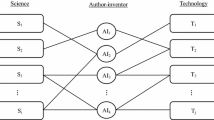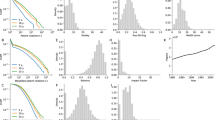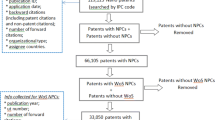Abstract
Discovering and assessing fields of expertise in emerging technologies from patent data is not straightforward. First, patent classification in an emerging technology being far from complete, the definitions of the various applications of its inventions are embedded within communities of practice. Because patents must contain full record of prior art, co-citation networks can, in theory, be used to identify and delineate the inventive effort of these communities of practice. However, the use patent citations for the purpose of measuring technological relatedness is not obvious because they can be added by examiners. Second, the assessment of the development stage of emerging industries has been mostly done through simple patent counts. Because patents are not all valuable, a better way of evaluating an industry’s stage of development would be to use multiple patent quality metrics as well as economic activity agglomeration indicators. The purpose of this article is to validate the use of (1) patent citations as indicators of technological relatedness, and (2) multiple indicators for assessing an industry’s development stage. Greedy modularity optimization of the ‘Canadian-made’ nanotechnology patent co-citation network shows that patent citations can effectively be used as indicators of technological relatedness. Furthermore, the use of multiple patent quality and economic agglomeration indicators offers better assessment and forecasting potential than simple patent counts.






Similar content being viewed by others
References
Abraham, B. P., & Moitra, S. D. (2001). Innovation assessment through patent analysis. Technovation, 21, 245–252.
Acs, Z. J., & Audretsch, D. B. (1989). Patents as a measure of innovative activity. Kyklos, 42(2), 171–180.
Albert, M. B., Avery, D., Narin, F., & McAllister, P. (1991) Direct validation of citation counts as indicators of industrially important patents. Research Policy, 20(3), 251–259.
Alcácer, J., & Gittelman, M. (2006) Patent citations as a measure of knowledge flows: The influence of examiner citations. Review of Economics and Statistics, 88(4), 774–779.
Alcácer, J., Gittelman, M., & Sampat, B. (2009) Applicant and examiner citations in U.S. patents: An overview and analysis. Research Policy, 38(2), 415-427.
Alencar, M. S. M., Porter, A. L., & Antunes, A. M. S. (2007). Nanopatenting patterns in relation to product life cycle. Technological Forecasting and Social Change, 74(9), 1661–1680.
Allison, J. R., Lemley, M. A., Moore, K. A., & Trunkey, R. D. (2004) Valuable patents. Georgetown Law Journal, 92(3), 435–479.
Andersen, B. (1999). The hunt for S-shaped growth paths in technological innovation: A patent study. Journal of Evolutionary Economics, 9, 487–526.
Archibugi, D., & Pianta, M. (1996). Measuring technological change through patents and innovation surveys. Technovation, 16(9), 451–468.
Audretsch, D. B., & Feldman, M. P. (1996) R&D spillovers and the geography of innovation and production. American Economic Review, 86(3), 630–640.
Azagra-Caro, J. M., Mattsson, P., & Perruchas, F. (2011) Smoothing the lies: The distinctive effects of patent characteristics on examiner and applicant citations. Journal of the American Society for Information Science and Technology, 62(9), 1727–1740.
Barabási, A.-L., & Albert, R. (1999). Emergence of scaling in random networks. Science, 286(5439), 509–512.
Barirani, A., Agard, B., & Beaudry, C. (2011). Competencce maps using agglomerative hierarchical clustering. Journal of Intelligent Manufacturing. doi:10.1007/s10845-011-0600-y.
Breitzman, A. (2005). Automated identification of technologically similar organizations. Journal of the American Society for Information Science and Technology, 56(10), 1015–1023.
Breitzman, A. F., & Mogee, M. E. (2002). The many applications of patent analysis. Journal of Information Science, 28(3), 187–205.
Callaert, J., Van Looy, B., Verbeek, A., Debackere, K., & Thijs, B. (2006) Traces of prior art: An analysis of non-patent references found in patent documents. Scientometrics, 69(1), 3–20.
Carpenter, M. P., Narin, F., & Wolf, P. (1981). Citation rates to technologically important patents. World Patent Information, 3(4), 160–163.
Chang, C. K. N., & Breitzman, A. (2009). Using patents prospectively to identify emerging, high-impact technological clusters. Research Evaluation, 18(5), 357–364.
Chang, P.-L., Wu, C.-C., & Leu, H.-J. (2010). Using patent analyses to monitor the technological trends in an emerging field of technology: A case of carbon nanotube field emission display. Scientometrics, 82, 5–19.
Cheng, Y.-H., Kuan, F.-Y., Chuang, S.-C., & Ken, Y. (2010). Profitability decided by patent quality? An empirical study of the US semiconductor industry. Scientometrics, 82, 175–183.
Clauset, A., Newman, M. E. J., & Moore, C. (2004). Finding community structure in very large networks. Physical Review E, 70, 066111.
Cohen, W. M., Nelson, R. R., & Walsh, J. P. (2000). Protecting their intellectual assets: Appropriability conditions and why US manufacturing firms patent (or not). NBER Working Paper No. 7552.
Daim, T. U., Rueda, G., Martin, H., & Gerdsri, P. (2006). Forecasting emerging technologies: Use of bibliometrics and patent analysis. Technological Forecasting and Social Change, 73, 981–1012.
Dang, Y., Zhang, Y., Fan, L., Chen, H., & Roco, M. C. (2010). Trends in worldwide nanotechnology patent applications: 1991 to 2008. Journal of Nanoparticle Research, 12(3), 687–706.
Dechenaux, E., Goldfarb, B., Shane, S., & Thursby, M. (2008). Appropriability and commercialization—Evidence from MIT inventions. Management Science, 54(5), 893–906.
ESF (2005). Nanomedicine. European Science Foundation.
Fitzgibbons, K., & McNiven, C. (2006). Towards a nanotechnology statistical framework, Blue Sky Indicators Conference II.
Fleming, L. (2001). Recombinant uncertainty in technological search. Management Science, 47(1), 117–132.
Fleming, L., & Sorenson, O. (2001). Technology as a complex adaptive system: Evidence from patent data. Research Policy, 30, 1019–1039.
Fortunato, (2010). Community detection in graphs. Physics Reports, 486, 75–174.
Freitas, R. A. (2005). What is nanomedicine? Disease-a-month, 51(6), 325–341.
Gallini, N. T. (2002). The economics of patents: Lessons from recent US patent reform. Journal of Economic Perspectives, 16(2), 131–154.
Girvan, M., & Newman, M. E. J. (2002). Community structure in social and biological networks. PNAS, 99(12), 7821–7826.
Grieneisen, M. L. (2010). The proliferation of nano journals. Nature Nanotechnology, 5(12), 825.
Hall, B. H., Jaffe, A., & Trajtenberg, M. (2005). Market value and patent citations. The Rand Journal of Economics, 36(1), 16–38.
Hall, B. H., & Ziedonis, R. H. (2001). The patent paradox revisited: An empirical study of patenting in the U.S. semiconductor industry, 1979–1995. The Rand Journal of Economics, 32(1), 101–128.
Harel, D., & Koren, Y. (2002). Graph drawing by high-dimensional embedding. Proceedings of the 9th International Symposium on Graph Drawing, pp. 207–219.
Hedge, D., & Sampat, B. (2009). Examiner citations, applicant citations, and the private value of patents. Economics Letters, 105, 287–289.
Huang, C., Notten, A., & Rasters, N. (2011). Nanoscience and technology publications and patents: A review of social science studies and search strategies. Journal of Technology Transfer, 36(2), 145–172.
Hullmann, A., & Meyer, M. (2003). Publications and patents in nanotechnology: an overview of previous studies and the state of the art. Scientometrics, 58(3), 507–527.
Hullmann, A. (2006). Who is winning the global nanorace? Nature Nanotechnology, 1(2), 81–83.
Jaffe, A. B., Trajtenberg, M. & Henderson, R. (1993) Geographic localization of knowledge spillovers as evidenced by patent citations. The Quarterly Journal of Economics, 108(3), 577–598.
Kostoff, R. N., Koytcheff, R. G., & Lau, C. G. Y. (2007). Global nanotechnology research metrics. Scientometrics, 70(3), 565–601.
Krugman, P. R. (1991) Increasing returns and economic geography. Journal of Political Economy, 99(3), 483–499.
Lanjouw, J. O., & Schankerman, M. (2004) Patent quality and research productivity: Measuring innovation with multiple indicators. Economic Journal, 114(495), 441–465.
Lerner, J. (1994) The importance of patent scope: An empirical analysis. RAND Journal of Economics, 25(2), 319–333.
Leydesdorff, L. (2008). Patent classifications as indicators of intellectual organization. Journal of the American Society for Information Science and Technology, 59(10), 1582–1597.
Li, X., Chen, H., Huang, Z., & Roco, M. C. (2007a). Patent citation network in nanotechnology (1976–2004). Journal of Nanoparticle Research, 9, 337–352.
Li, X., Chen, H., Zhang, Z., & Li, J. (2007b). Automatic patent classification using citation network information: An experimental study in nanotechnology. Proceedings of the 7th ACM/IEE Joint Conference on Digital Libraries, pp. 419–427.
Li, X., Lin, Y., Chen, H., & Roco, M. C. (2007c). Worldwide nanotechnology development—A comparative study of USPTO EPO and JPO. Journal of Nanoparticle Research, 9, 977–1002.
Li, X., Hu, D., Dang, Y., Chen, H., Roco, M. C., Larson, C. A., et al. (2009). Nano Mapper: An Internet knowledge mapping system for nanotechnology development. Journal of Nanoparticle Research, 11(3), 529–552.
Maghrebi, M., Abbasi, A., Amiri, S., Monsefi, R., & Harati, A. (2011). A collective and abridged lexical query for delineation of nanotechnology publications. Scientometrics, 86, 15–25.
Martin, B. R. (1995). Foresight in science and technology. Technology Analysis & Strategic Management, 7(2), 139–168.
Malmberg, A., & Maskell, P. (2002) The elusive concept of localization economies: Towards a knowledge-based theory of spatial clustering. Environment and Planning A, 34(3), 429–449.
Merges, R. P., & Nelson, R. R. (1990) On the complex economics of patent scope. Columbia Law Review, 90(4), 839–916.
Meyer, P. (1994) Bi-logistic growth. Technological Forecasting and Social Change, 47(1), 89–102.
Meyer, M. (2000a). What is special about patent citations? Differences between scientific and patent citations. Scientometrics, 49(1), 93–123.
Meyer, M. (2000b). Patent citations in a novel field of technology: What can they tell about interactions between emerging communities of science and technology. Scientometrics, 48(2), 151–178.
Meyer, M., & Persson, O. (1998). Nanotechnology: Interdisciplinarity, patterns of collaboration and differences in application. Scientometrics, 42(2), 195–205.
Mogoutov, A., & Kahane, B. (2007). Data search strategy for science and technology emergence: A scalable and evolutionary query for nanotechnology tracking. Research Policy, 36, 893–903.
Moore, K. A. (2005). Worthless patent’s. George Mason Law & Economics Research Paper No. 04-29.
Narin, F. (1994). Patent bibliometrics. Scientometrics, 30(1), 147–155.
Narin, F., & Hamilton, K. S. (1996). Bibliometric performance measures. Scientometrics, 36(3), 293–310.
Nerkar, A., & Shane, S. (2007). Determinants of invention commercialization: An empirical examination of academically sourced inventions. Strategic Management Journal, 28, 1155–1166.
Newman, M. E. J., & Girvan, M. (2004). Finding and evaluating community structure in networks. Physical Review E, 69, 026113.
Owen-Smith, J., & Powell, W. W. (2004) Knowledge networks as channels and conduits: The effects of spillovers in the Boston biotechnology community. Organization Science, 15(1), 5-21.
Pavitt, K. (1985). Patent statistics as indicators of innovative activities: Possibilities and problems. Scientometrics, 7(1–2), 77–99.
Pei, R., & Porter, A. L. (2011). Profiling leading scientists in nanobiomedical science: Interdisciplinarity and potential leading indicators of research directions. R&D Management, 41(3), 288–306.
Perkel, J. M. (2004). The ups and downs of nanobiotech. The Scientist, 18(16), 14–18.
Porter, M. E. (1998) Clusters and the new economics of competition. Harvard Business Review, 76(6), 77–90.
Porter, A. L., Youtie, J., Shapira, P., & Schoeneck, D. J. (2008). Refining search terms for nanotechnology. Journal of Nanoparticle Research, 10(5), 715–728.
Reitzig, M., Henkel, J., & Hearth, C. (2007). On sharks, trolls, and their patent prey—Unrealistic damage awards and firms’ strategies of “being infringed”. Research Policy, 36, 134–154.
Rosenberg, N. (1994). Exploring the black box: Technology, economics, and history. New York: Cambridge University Press.
Sampat, B. N. (2005) Determinants of patent quality: An empirical analysis. Working Paper. Available at http://www.immagic.com/eLibrary/ARCHIVES/GENERAL/COLUMBIA/C050902S.pdf.
Schmoch, U., Heinze, T., Hinze, S., & Rangnow, R. (2003). Mapping excellence in science and technology across Europe: Nanoscience and nanotechnology. Centre for Science and Technology Studies.
Small, H. (1973). Co-citation in the scientific literature: A new measure of the relationship between two documents. Journal of the American Society for Information Science, July–August, pp. 265–269.
Takeda, Y., Mae, S., Kajikawa, Y., & Matsushima, K. (2009). Nanobiotechnology as an emerging research field from nanotechnology: A bibliometric approach. Scientometrics, 80(1), 23–38.
Tong, X., & Frame, J. D. (1994) Measuring national technological performance with patent claims data. Research Policy, 23(2), 133–141.
Trajtenberg, (1990). A penny for your quotes: Patent citations and the value of innovations. The Rand Journal of Economics, 21(1), 172–187.
Wallace, M. L., Gingras, Y., & Duhon, R. (2009) A new approach for detecting scientific specialties from raw cocitation networks. Journal of the American Society for Information Science and Technology, 60(2), 240–246.
Watts, R. J., & Porter, A. L. (1997). Innovation forecasting. Technological Forecasting and Social Change, 56(1), XIV–XIV47.
Watts, D. J., & Strogatz, S. H. (1998). Collective dynamics of ‘small-world’ networks. Nature, 393(6684), 440–442.
Webster, E., & Jensen, P. H. (2011). Do patents matter for commercialization? Journal of Law and Economics, 54(2), 431–453.
Wenger, E. (1999) Communities of practice: Learning, meaning, and identity. Cambridge University Press.
Zitt, M., & Bassecoulard, E. (2006). Delineating complex scientific fields by an hybrid lexical-citation method: An application to nanosciences. Information Processing and Management, 42, 1513–1531.
Zucker, L. G., Darby, M. R., & Brewer, M. B. (1998) Intellectual human capital and the birth of US biotechnology enterprises. American Economic Review, 88(1), 290–306.
Acknowledgments
We would like to thank the SSHRC, the CIHR and the NSERC for their financial support. We are also immensely indebted to two anonymous reviewers who have contributed to raising the quality of this article through their insightful comments and recommendations.
Author information
Authors and Affiliations
Corresponding author
Rights and permissions
About this article
Cite this article
Barirani, A., Agard, B. & Beaudry, C. Discovering and assessing fields of expertise in nanomedicine: a patent co-citation network perspective. Scientometrics 94, 1111–1136 (2013). https://doi.org/10.1007/s11192-012-0891-6
Received:
Published:
Issue Date:
DOI: https://doi.org/10.1007/s11192-012-0891-6




